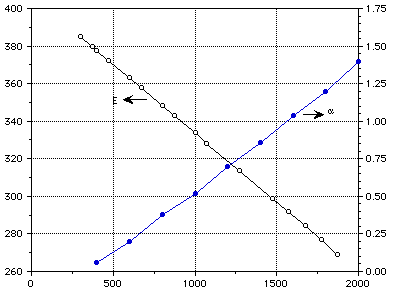 (1)
(1)Aluminium oxide is a ceramic with properties suitable for a coating material and electrical insulator. Its general properties are as follows :
GENERAL PROPERTIES - ALUMINIUM OXIDE [1]
Physical properties
Melting Point : 2000 +/- 30 C
Density at RT : 3.9 g/cm3
Apparent Porosity : 0 %
Water Absorption-Saturation : 0 %
Electrical properties
Dielectric Constant : 9.0 - 10.1
Dielectric Strength : 10 - 35 kV/mm
Volume Resistivity @ 20 C : > 1014 [[Omega]] cm
Thermal properties
Thermal Conductivity @ 20 C : 28 - 35 W/m-K
Thermal Expansivity, 20 - 1000 C : 8.0 x10-6m/m-K
Upper Continuous Use Temperature : 1800 C
Mechanical properties
Compressive Strength : 2200 - 2600 MPa
Shear Strength : 330 MPa
Hardness-Vickers : 1500 - 1650 kgf/mm2
Tensile Modulus : 330 - 400 GPa
DATA AND CORRELATIONS
It should be noted that the chemical resistance of Al2O3 to concentrated and/or dilute acids, alkalis, halogens and metals is quite good. The thermal and structural properties as a function of temperature are presented in Table 1, refs [2, 3]. Property values in ref [4] are also similar to the values appearing in Table 1.
Figures 1-2 show the variation of properties with temperature and Fig 3 shows the effect of porosity on the thermal conductivity. Polynomial correlations of the thermal and structural properties as functions of temperature in degrees K, using the data of Table 1, are as follows:
 (1)
(1)
 (2)
(2)
 (3)
(3)
 (4)
(4)
Equations (1) and (4) are valid between 298-2000 K, Eq (2) between 298-1600 K and Eq (3) between 373-2000 K.
TABLE 1 Thermal and structural properties of aluminium oxide
T K [[rho]] E GPa [[nu]] k W/m-K C J/kg-K [[sigma]] [[alpha]]
kg/m3 y MPa (10-6)
m/m-K
298 3900 385.169 0.254 37.1754 782.218
300 385.078 36.9601 785.025
373 379.674 30.2503 901.3683 0.0388
400 377.696 27.2090 942.030 0.060
473 372.348 22.5099 1016.802 0.114
500 370.397 20.9300 1046.700 0.134
600 363.044 16.3045 1109.502 0.200
673 357.696 13.1378 1148.873 0.267
700 355.715 12.5580 1151.370 0.288
800 348.392 10.4650 1203.705 0.380
873 343.044 9.1211 1214.92 0.424
900 341.034 8.9999 1224.639 0.446
1000 333.740 7.9534 1235.106 0.520
1073 328.392 7.1965 1249.819 0.587
1100 326.352 7.1792 1256.040 0.609
1200 319.0116 6.8023 1272.787 0.700
1273 313.740 6.1505 1284.489 0.753
1300 311.671 6.2467 1285.348 0.776
1400 304.330 5.9651 1297.500 0.860
1473 299.088 5.7992 1308.00 0.925
1500 296.989 5.8604 1308.375 0.948
1573 291.762 5.8604 1308.375 1.012
1600 289.649 5.8604 1308.375 1.040
1673 284.436 1.101
1773 277.110 1.190
1800 274.967 1.200
1873 269.051 12881
2000 260.286 1.400
k (W/m-K) c (J/kg-K)

Figure 1: Thermal conductivity and specific heat of aluminium oxide.
E (GPa) [[alpha]] (10-6 m/m-K)

Temperature (K)
Figure 2: Elastic modulus and thermal expansion coefficient as a function of temperature for aluminium oxide

Figure 3: The effect of porosity on the thermal conductivity of aluminum oxide as a function of temperature.